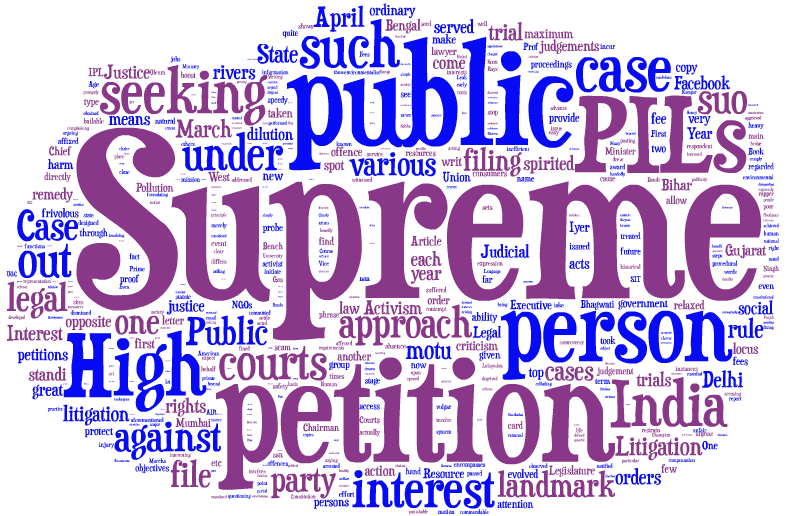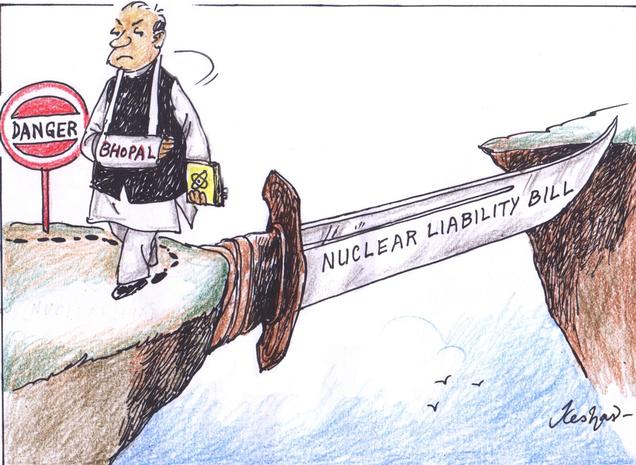
The expression ‘Public Interest Litigation’ has been borrowed from American jurisprudence, where it was designed to provide legal representation to previously unrepresented groups like the poor, the racial minorities, unorganised consumers, citizens who were passionate about the environmental issues, etc.

You must have come across this phrase quite often, at least in the news. PIL has achieved a place of great importance in our legal system. The term is not expressly defined under any statute. The meaning has evolved out of various judgments. It simply means that any public spirited person can approach the court for a public cause or public interest or public welfare by filing a petition. The question which often arises in this context is what can be regarded as “public interest”? Clearly, “any act for the benefit of public is in public interest.”
In India, the first PIL was filed in the year 1976; Mumbai Kamgar Sabha v. M/s Abdulbhai Faizullabhai and others [1976 (3) SCC 832]. The seed of PIL was sown by Justice Krishna Iyer through this landmark judgement. Soon thereafter, with the efforts of Justice Bhagwati, the concept of PIL has evolved and developed to a great extent. He is in-fact known as the Champion of PIL in India!
The other historical PIL is the one filed for prisoner’s rights Hussainara Khatoon v. State of Bihar. Many has regarded this case as the first PIL in India as well. In this case the attention of the court was drawn to the incredible situation of under trials in Bihar who had been detained pending trial for periods far in excess of the maximum sentence for the offences they were charged with. The court not only proceeded to make the right to speedy trial the central issue of the case but passed the order of general release of close to 40,000 under trials who had undergone detention beyond such maximum period.
What is Public interest litigation?
Public Interest Litigation differs from ordinary litigation. It does not involve the enforcement of the rights of one person against another. Rather, this type of litigation is filed to provide justice to the deprived sections of the society. It is a collaborative effort that encompasses the petitioner, the court and the government. It is commendable to see that courts have taken all possible measures to allow access to public spirited persons and even NGOs to file petitions on behalf of those who cannot approach the court.
A very prominent PIL activist in India is, Mr. M.C. Mehta: a lawyer by profession and a committed environmentalist by choice. From the scores of PILs he filed, it seems his mission in life was to protect the environment. He has single-handedly obtained about 40 landmark judgements and numerous orders from the Supreme Court against environmental offenders. Some of the landmark judgements arising out of PILs filed by him are:
- The Oleum Gas Leak Case
- The Delhi Vehicular Pollution Case
- The Child Labour Case
- The Gamma Rays Case
- The Ganga Pollution Case.. to name a few.
The Supreme Court has performed Judicial Activism by passing various orders and judgements in PILs. The expression “Judicial Activism” signifies the anxiety of the courts to find out an appropriate remedy for the aggrieved person by formulating a new rule to settle the conflicting questions in the event of uncertain laws or absence of any law on a given point.
How to file a PIL
In India, a PIL can be filed in the Supreme Court under Article 32 and in the High Courts under Article 226 of the Constitution of India.
The Supreme Court has taken various steps that have given a healthy boost to PIL. The procedural requirements are very easy and relaxed as compared to filing of other ordinary petitions. Even a letter, post card, newspaper report or email addressed to the Supreme Court by a person, acting in public interest has been accepted as a petition. Any simple information received by the court complaining of a legal injury against a person or a group of persons, who cannot approach the court directly (because of poverty, disability, social backwardness and the like) can be treated as a PIL. The courts understand that in such cases it would be unfair to expect a person to incur expenses and approach the court through ordinary litigation.
In a landmark judgment, D.K. Basu v State of West Bengal, the court acted upon a letter petition which drew attention to the repeated instances of custodial deaths in West Bengal. The court further mandated that a relative of the arrested must be promptly notified. It made clear that the failure to comply with this direction would be punishable as contempt of court. The early PILs had witnessed the award of compensation by the court to victims of human rights violations. This practice of initiating proceedings on the basis of letters has now been streamlined and has come to be described as ‘epistolary jurisdiction’.
Also, the Supreme Court has relaxed the rule of locus standi while filing PILs. Locus standi means the ability of a person to approach the court having sufficient connection to the case in hand. In other words, a person who has actually suffered a legal harm has the ability to approach a court seeking a remedy. However, in the case of PIL, any public-spirited person, who may not be directly affected by the legal harm, can approach the court, seeking a remedy.
It is pertinent to be noted that once a PIL has been filed, it cannot be withdrawn. The courts might also take suo motu cognizance of matters involving public interest. suo motu is the power of the court to initiate proceedings against a party by its own motion.
However, the procedure to file a PIL is similar to that of a writ petition.
In High Court
If a Public Interest Litigation is filed in a High court, then two (2) copies of the petition have to be filed. Also, an advance copy of the petition has to be served on the each respondent, i.e. opposite party, and this proof of service has to be affixed on the petition.
In Supreme Court
If a Public Interest Litigation is filed in the Supreme court, then (4)+(1) (i.e. 5) sets of petition has to be filed opposite party is served, the copy only when notice is issued.
Court Fees
A Court fee of Rs. 50, per respondent (i.e. for each number of opposite party, court fees of RS. 50) has to be affixed on the petition.
Criticisms of PIL
PILs have been subject to a lot of criticism in recent times. One of the main criticisms is that by entertaining PILs and exercising Judicial Activism, Courts are trying to usurp the functions of the Legislature and Executive. Justice Bhagwati, in the judgement of Bandu Mukti Morcha v. Union of India [AIR 1984 SC 802] had observed that the courts by performing the aforementioned actions are merely assisting in the realisation of the constitutional objectives of the Judiciary and not usurping the functions of the Legislature and Executive.
Another criticism is the major dilution of the principle of locus standi. It has been argued that such dilution has opened up the floodgates for frivolous cases that either involves the litigant’s private interests, or for seeking publicity rather than seeking justice, or to stage their political objectives. In such cases, the petitions have been dismissed and heavy costs have been imposed by the courts. This acts as a deterrent to people from filing such PILs in future.
Some interesting PILs filed in the past one year
- May 2013: A PIL has been filed in the Delhi High Court saying that the Prime Minister of India’s Facebook Page shows a distorted picture of the national flag.
- May 2013: PIL has been filed in the Supreme Court seeking SIT probe into IPL spot-fixing scam.
- April 2013: PIL filed in the Supreme Court seeking to restrain government authorities from taking any coercive action against anyone for posting alleged objectionable comments on social networking sites like Facebook.
- March 2013: PIL in the Supreme Court filed by a lawyer seeking orders to make the offence of watching pornography a non-bailable offence.
- February 2013: PIL filed against rapper Yo Yo Honey Singh in the Punjab and Haryana High Court for the offensive and vulgar lyrics of his various songs.
- April 2012: 2 PILs filed in the Delhi High Court accusing the Union Human Resource Development Ministry of colluding with a particular candidate, another arguing that candidates being considered for the UGC top jobs of Chairman and Vice Chairman are either ineligible or inefficient.
- April, 2012: The Gujarat High Court took up suo motu action for the safety and maintenance of the bridge from where Mahatma Gandhi had launched his historic Dandi March in 1930
- March 2012: PIL filed in the Madurai Bench of the Madras High Court to stop san quarrying in the rivers Cauvery and Kollidam, in order to protect the natural resources of these rivers.
- March 2012: The Supreme Court threw out a petition questioning the appointment of Gujarat Governor Kamla Beniwal and seeking her removal for appointing state Lokayukta disregarding the Chief Minister’s objections, calling the petition frivolous and fined the party heavily.
- January, 2012: PIL filed on Army Chief’s Age controversy, in the Supreme Court.
Resource: Prof. H.D. Pithawala’s Book: Legal Language and Legal Writing for the students of the First Year of the Five Year Law Course, Mumbai University
 Serato DJ Crack 2025Serato DJ PRO Crack
Serato DJ Crack 2025Serato DJ PRO Crack



 Allow notifications
Allow notifications
